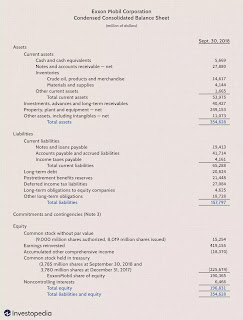Balance sheet
- reports a company's assets, liabilities and shareholders' equity at a specific point in time
- i.e., a snapshot of what a company owns and owes, as well as the amount invested by shareholders
- Formula
- Assets=Liabilities+Shareholders’ Equity
- a company has to pay for all the things it owns (assets) by either borrowing money (taking on liabilities) or taking it from investors (issuing shareholders' equity)
- Assets
- listed from top to bottom in order of their liquidity
- i.e., the ease with which they can be converted into cash
- Current assets
- Case and case equivalents
- e.g., hard currency (e.g., $), treasury bills, short-term certificates of deposit (i.e., CD)
- Marketable securities
- e.g., common stocks, treasury bills, etc.
- Accounts receivables
- Inventory
- Prepaid expenses
- e.g., insurance, advertising contracts or rent
- Non-current or long-term assets
- i.e., will not or cannot be liquidated in the next year
- Fixed assets
- e.g., land, machinery, equipment, buildings
- Intangible assets
- e.g., intellectual property and goodwill
- Liabilities
- Current liabilities
- due within one year
- e.g., bank indebtedness, interest payable, wages payable, customer prepayments, dividends payable, accounts payable, current portion of long-term debt
- Long-term liabilities
- due at any point after one year
- e.g., interest and principal on bonds issued, pension fund liability (i.e., pay into employees' retirement accounts), deferred tax liability
- Shareholders' equity
- i.e., the money attributable to a business' owners (i.e., net assets)
- Retained earnings
- i.e., the amount of net income left over for the business after it has paid out dividends to its shareholders
- Treasury stocks, etc.

No comments:
Post a Comment